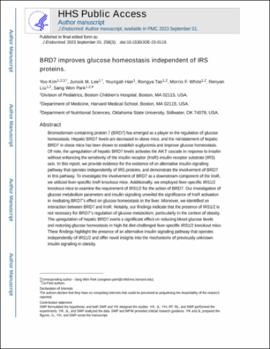| dc.contributor.author | Kim, Yoo | |
| dc.contributor.author | Lee, Junsik M. | |
| dc.contributor.author | Han, Youngah | |
| dc.contributor.author | Tao, Rongya | |
| dc.contributor.author | White, Morris F. | |
| dc.contributor.author | Liu, Renyan | |
| dc.contributor.author | Park, Sang Won | |
| dc.date.accessioned | 2023-09-12T20:03:07Z | |
| dc.date.available | 2023-09-12T20:03:07Z | |
| dc.date.issued | 2023-09-01 | |
| dc.identifier | oksd_kim_BRD7_improves_glucose_homeostasis_2023 | |
| dc.identifier.citation | Kim, Y., Lee, J.M., Han, Y., Tao, R., White, M.F., Liu, R., Park, S.W. (2023). BRD7 improves glucose homeostasis independent of IRS proteins. The Journal of endocrinology, 258(3), pp. e230119-. https://doi.org/10.1530/JOE-23-0119 | |
| dc.identifier.issn | 0022-0795 | |
| dc.identifier.uri | https://hdl.handle.net/11244/339570 | |
| dc.description.abstract | Bromodomain-containing protein 7 (BRD7) has emerged as a player in the regulation of glucose homeostasis. Hepatic BRD7 levels are decreased in obese mice, and the reinstatement of hepatic BRD7 in obese mice has been shown to establish euglycemia and improve glucose homeostasis. Of note, the upregulation of hepatic BRD7 levels activates the AKT cascade in response to insulin without enhancing the sensitivity of the insulin receptor (InsR)-insulin receptor substrate (IRS) axis. In this report, we provide evidence for the existence of an alternative insulin signaling pathway that operates independently of IRS proteins and demonstrate the involvement of BRD7 in this pathway. To investigate the involvement of BRD7 as a downstream component of InsR, we utilized liver-specific InsR knockout mice. Additionally, we employed liver-specific IRS1/2 knockout mice to examine the requirement of IRS1/2 for the action of BRD7. Our investigation of glucose metabolism parameters and insulin signaling unveiled the significance of InsR activation in mediating BRD7's effect on glucose homeostasis in the liver. Moreover, we identified an interaction between BRD7 and InsR. Notably, our findings indicate that IRS1/2 is not necessary for BRD7's regulation of glucose metabolism, particularly in the context of obesity. The upregulation of hepatic BRD7 significantly reduces blood glucose levels and restores glucose homeostasis in high-fat diet-challenged liver-specific IRS1/2 knockout mice. These findings highlight the presence of an alternative insulin signaling pathway that operates independently of IRS1/2 and offer novel insights into the mechanisms of a previously unknown insulin signaling in obesity. | |
| dc.format | application/pdf | |
| dc.language | en_US | |
| dc.publisher | Bioscientifica | |
| dc.relation.ispartof | Journal of Endocrinology, 258 (3) | |
| dc.relation.uri | https://www.ncbi.nlm.nih.gov/pubmed/37578842 | |
| dc.rights | This material has been previously published. In the Oklahoma State University Library's institutional repository this version is made available through the open access principles and the terms of agreement/consent between the author(s) and the publisher. The permission policy on the use, reproduction or distribution of the material falls under fair use for educational, scholarship, and research purposes. Contact Digital Resources and Discovery Services at lib-dls@okstate.edu or 405-744-9161 for further information. | |
| dc.subject.mesh | animals | |
| dc.subject.mesh | mice | |
| dc.subject.mesh | glucose | |
| dc.subject.mesh | homeostasis | |
| dc.subject.mesh | insulin | |
| dc.subject.mesh | insulin receptor substrate proteins | |
| dc.subject.mesh | insulin resistance | |
| dc.subject.mesh | liver | |
| dc.subject.mesh | mice, knockout | |
| dc.subject.mesh | mice, obese | |
| dc.subject.mesh | obesity | |
| dc.subject.mesh | receptor, insulin | |
| dc.subject.mesh | transcription factors | |
| dc.title | BRD7 improves glucose homeostasis independent of IRS proteins | |
| dc.date.updated | 2023-09-09T16:17:25Z | |
| osu.filename | oksd_kim_BRD7_improves_glucose_homeostasis_2023.pdf | |
| dc.identifier.doi | 10.1530/JOE-23-0119 | |
| dc.description.department | Nutritional Sciences | |
| dc.type.genre | Article | |
| dc.type.material | Text | |
| dc.subject.keywords | agricultural, veterinary and food sciences | |
| dc.subject.keywords | animal production | |
| dc.subject.keywords | biomedical and clinical sciences | |
| dc.subject.keywords | clinical sciences | |
| dc.subject.keywords | diabetes | |
| dc.subject.keywords | liver disease | |
| dc.subject.keywords | obesity | |
| dc.subject.keywords | digestive diseases | |
| dc.subject.keywords | nutrition | |
| dc.subject.keywords | biological and endogenous factors | |
| dc.subject.keywords | aetiology | |
| dc.subject.keywords | metabolic and endocrine | |
| dc.subject.keywords | oral and gastrointestinal | |
| dc.subject.keywords | brd7 | |
| dc.subject.keywords | glucose metabolism | |
| dc.subject.keywords | insulin receptor signaling | |
| dc.subject.keywords | insulin receptor substrates | |
| dc.subject.keywords | animal production | |
| dc.subject.keywords | veterinary sciences | |
| dc.subject.keywords | clinical sciences | |
| dc.subject.keywords | endocrinology and metabolism | |
| dc.identifier.author | ORCID: 0000-0002-4525-1319 (Kim, Y) | |
| dc.identifier.author | ScopusID: 57207443072 | 57218459560 | 57687368900 (Kim, Y) | |
| dc.identifier.author | ScopusID: 57208087435 (Lee, JM) | |
| dc.identifier.author | ScopusID: 57196467645 (Han, Y) | |
| dc.identifier.author | ScopusID: 23502160400 (Tao, R) | |
| dc.identifier.author | ScopusID: 57201649103 (White, MF) | |
| dc.identifier.author | ScopusID: 57208085082 (Liu, R) | |
| dc.identifier.author | ORCID: 0000-0001-7764-3133 (Park, SW) | |
| dc.identifier.author | ScopusID: 57221241337 (Park, SW) | |
| dc.identifier.essn | 1479-6805 | |
